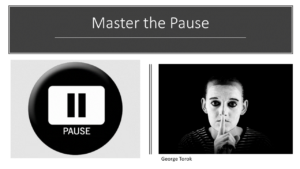Master the Pause to become a Powerful Communicator
Master the Pause to become a Powerful Communicator
When you are speaking, how would you feel about saying nothing? Simply pausing?
Awkward? Uncomfortable? Anxious?
It might be the most difficult communication skill, the dramatic use of silence. Consider that the most effective technique is to say nothing. That means, that sometimes, you need to stop talking.
The use of the dramatic pause might be the most powerful tool in your communication toolbox.
“The right word may be effective, but no word was ever as effective as a rightly timed pause.”
Mark Twain
The pause requires self-discipline and self-confidence. To master the pause, you must become comfortable with both silence and uncertainty.
Overcome the fear of silence.
Silence can feel discomforting for the speaker. Strangely, the pause might generate uncertainty for the speaker. I say that’s strange because the only way for the speaker to be certain about the audience is to listen for their response.
Why is mastery of silence such a powerful communication tool?
Because most people can’t tolerate the vacuum of silence. It can feel scary.
Did you know that when you are negotiating, the one who speaks less usually wins? The one who talks too much tends to give away valuable information and more concessions. The lesson: once you’ve stated your position, stop talking!
Did you know that your audience will listen more intently when you include more pauses in your presentation? Allow them time to think.
Use the pause to emphasize.
Pause immediately before you state something important to enhance anticipation. Pause right after you stated an important point to allow the audience to digest your message. The opening and closing pauses punch up the words between them.
Did you know that your audience can either listen or think – but not both at the same time. When you want them to think – shut up.
To demonstrate more confidence, pause more often and more dramatically.
Why? Because speakers who talk nonstop sound nervous and deceitful. It is as if they don’t want anyone else to challenge them or even think about their message.
To demonstrate real control and self-confidence pause before you start your presentation. After you have been introduced, move to center stage, plant your feet then smile while looking at the audience for at least three seconds while saying nothing.
It’s only three seconds and it might feel like eons for you. But it will have a magical effect on the audience. They will stop fidgeting, focus on you and be waiting for the first word out of your mouth. While you might feel uncomfortable during those three seconds, the audience will be marveling at your self-confidence and composure.
“The notes I handle no better than many pianists. But the pauses between the notes–ah, that is where the art resides!”
Arthur Schnabel,
Austrian composer & pianist (1882 – 1951)
After you master the 3-second pause, work on your 5-second and then 8-second pause.
Imagine how powerful you will appear to the audience.
Master the Pause to become a Powerful Communicator
See the pause in action at the beginning of this presentation…
Poor presentation creates stress, wastes time and loses money. George Torok, President of Superior Presentations, helps presenters deliver the intended message for greater success. You can arrange for individual coaching or team training – online or onsite.
Arrange Presentation Skills training for your team
http://superiorpresentations.net/
Connect with George Torok on Linkedin
https://www.linkedin.com/in/georgetorokpresentations/
Listen to the podcast – Your Intended Message with host. George Torok
https://yourintendedmessage.podbean.com/


